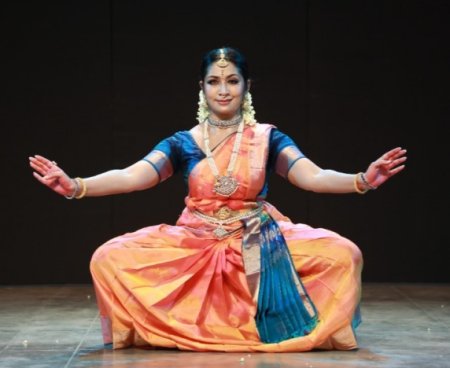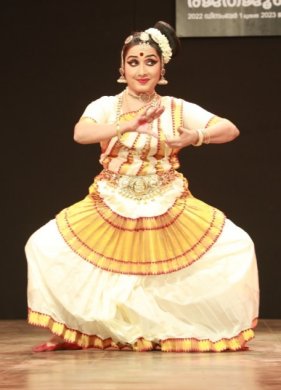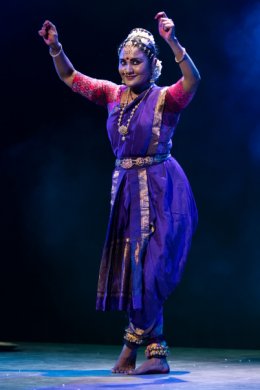
|   |

|   |
Edapally Nritaswadaka Sadas - Harish Bal e-mail: harishbal77@gmail.com December 12, 2022 Changampuzha Samskarika Kendram in Edapally, Kochi, has gone on to claim a prime place in the cultural map of Kerala and is in its silver jubilee year. Edapally Nritaswadaka Sadas, under the umbrella of Changampuzha Samskarika Kendram, celebrated its annual festival with three young and established artistes.  Navya Nair (Photo: Dineesh Komath) As in the past years, Nrithaswadaka Sadas opened its dance festival with a crowd puller, movie actress and dancer Navya Nair. Navya had proved her caliber as a dancer by becoming a Kalathilakam in Kerala youth festival before becoming a front running actress in Malayalam cinema. After a hiatus, she receives expert guidance in Bharatanatyam from veteran guru Manu Master of the Thanjavur tradition. After a pushpanjali to Srividya Ganapthi, Navya danced the oft performed varnam 'Mohamaginen inda velayil' in Kharaharapriya ragam composed by Dandayudhapani Pillai. She portrayed a virahotkhandita nayika, who, in her pangs of separation from lord Nataraja, loses interest in her favorite pursuits like playing the veena and other arts. In the second line 'yogamigum ambalam tannil natanamadum', the dancer showed the grand dance of lord Nataraja in the ponnambalam. Navya was neat and precise in her nritta segments. The adavus were marked with clarity and punch. This was again noticed in the teermanam in the introduction of the charanam. Flashes of her mentor Manu Master was evident in the striking poses, hip bends and sharp turns. However, the abhinaya was nothing to write home about, just uninspired miming. In line four 'vahan ennai maraivan', the dancer showed the heroine's eagerness and preparation to receive the lord.  Neena Prasad (Photo: Dineesh Komath) On the second day, Neena Prasad, the consummate Mohiniyattom artiste she has been over the past two decades and more, proved yet again that great dance is much more than perfect technique and style. The thinking dancer in Neena emerged in her interpretation of 'Draupadi', which she based on Odiya writer Pratibha Ray's novel 'Yagnaseni'. This was in the format of a varnam penned by Attingal Ravi and was set to Lathangi raga. 'Sakhe Krishnasakhe' is Draupadi's ode to Krishna as she lays dying and deserted by her husbands during the 'mahaprasthana'. The pure dance sequences were minimal in the first half and were more in the second half with the swaras. Neena traced splendidly the angst of the 'neethi nirasitha Draupadi', for whom others, her father and her husbands, decided the course of her life. The dancer smartly avoided elaborating episodes like Draupadi's swayamvara and Dussasana disrobing her in the Kuru court. A dramatic highpoint was Arjuna shooting down the toy bird in the contest. In the charanam, Draupadi envisions of another birth with a single, loving and protecting husband and worthy sons. Neena started her concert with a 'nadai cholukettu', a pure dance item with the complex rhythmic pattern in alternating chaturasra and misra nadais in adi tala. Neena, an exponent of Mohiniyattom nritta and her music ensemble carried off this feat admirably well. The dancer, with her guru Kalamandalam Sugandhi, has done substantial research in collating and codifying adavus in Mohiniyattom. This effort was palpable in the immense variety in rhythm and body movements, and gaits that were packed into this item. This was again evinced in the Kapi raga tillana that was steeped in lasya, as the vibrance of the tillana was softened down to suit the lilting moves of the dance. Another delectable item in the dancer's presentation, Swati Tirunal's 'Utsava Prabandha kriti' in Todi raga 'Pankajakshanam Ramesan' shone in her lucid interpretation. She traced lord Padmanabha's procession in a palanquin and the lord's immense form with the thousand headed serpent Anantha. In the line 'Bhaktalokam ashumodam bashpavari thookiyum', the dancer depicted the reaction of different devotees and their gratification on having a darshan of the lord. Likewise an old woman, a devotee carrying a child all were vividly sketched. The dancer's interpretation of 'Ramathe Yamuna pulinavane' ashtapadi saw Radha in a mood of 'aalasya' and indifference to the sight of flowers and cool breeze from the lake. She fantasizes Krishna in the company of another woman. Entreated by her sakhi, Radha leaves to meet Krishna. The dancer's transformation to the role of Krishna was noteworthy. He tells Radha to become one with him as he is the supreme Narayana.  Sreelakshmy Govardhanan (Photo: T Sreeraj) Sreelakshmy Govardhanan charmed an enthused audience with her acting prowess and grace in a Kuchipudi concert on the third day. The piece de resistance was a Krishna stuti which featured navarasas through the many aspects of Krishna's childhood. Hence 'veera rasa' found expression in the lifting of Govardhana mount, 'hasya' was shown in his mirth while stealing the clothes of gopis and so on. The main vinyasa was shown in the episode of Poothana in portraying 'beebhatsa'. The depiction borrowed much from 'Poothanamoksham' in Kathakali. Poothana's transformation from her terrifying self to that of a lovely maiden was dramatic, and so was her final end as Krishna sucks and drains her life blood. Every limb of her body paralyses, she suffers in agony and falls back with a thud. Though she is taken by anger and hate, she also softens as she is filled with 'vatsalya' or love for the infant Krishna. These contrasting emotions were handled with restraint and ease. The dancer incorporated the dance on the brass plate which she did with verve and dexterity. Sreelakshmy also performed a traditional Kuchipudi piece 'Oura shabdam' that the court dancer presents as an ode in praise of the king. The striking flavor of Kuchipudi music and rhythm with its characteristic gaits and movements came forth beautifully which hails the king as one who is handsomer than Kama, more generous than Karna and mightier than the oceans. As is usual at Changampuzha Samskarika Kendram, the dance shows had packed audiences who were regaled by seasoned and young dancers, who had fresh artistic ideas and content to share and enthrall the audience.  Harish Bal has been an art writer for over 20 years. His reviews and features have appeared in The Hindu, Sruti and several magazines and portals. He conducts programs on art for Doordarshan and All India Radio. He is also a classical musician and corporate trainer. |